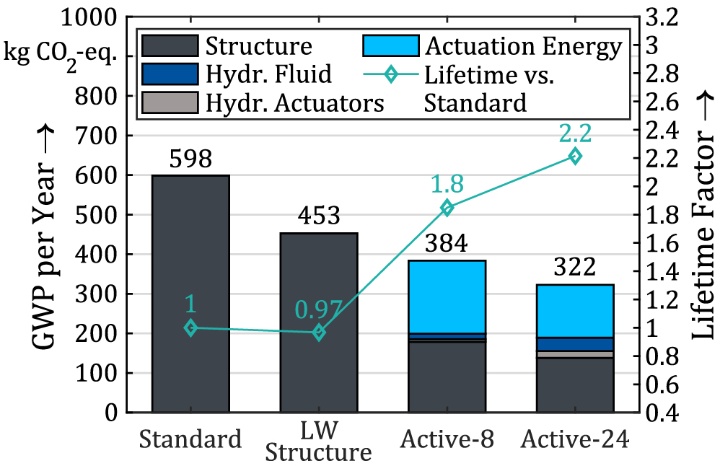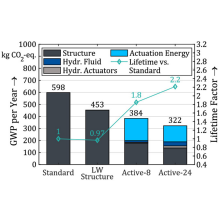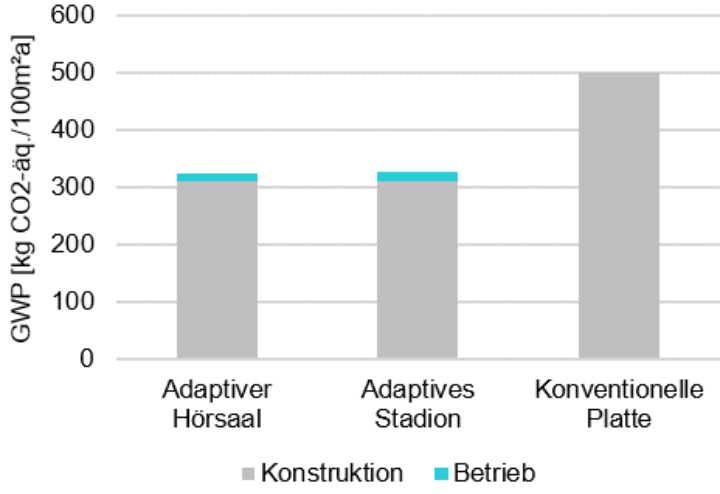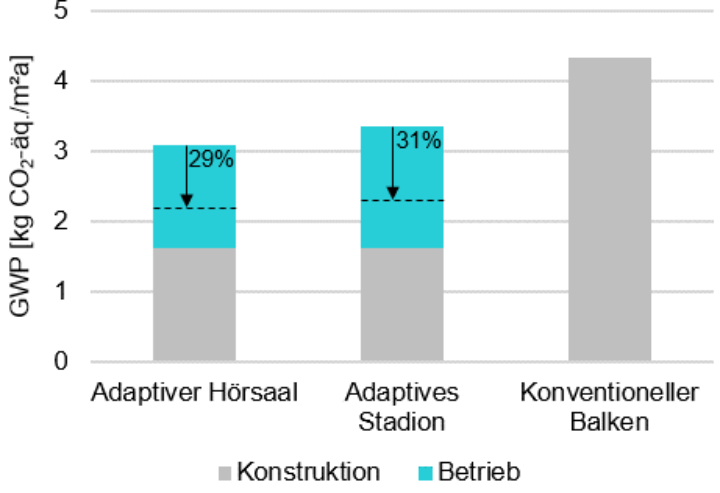Funding Phase II
The starting point for the work in D02 is the life cycle assessment method. So far, construction products have been statically and deterministically assessed. The dynamics of adaptive buildings or subsystems have not or only partially been considered in the life cycle assessment yet.
The comprehensive system investigation of adaptive envelopes and structures, which was the research focus in the first funding phase, enables the methodical integration of environmental impacts into the planning process of adaptive buildings. The complex interplay of the various influencing parameters, their requirements and the decision-making processes in planning results in a large number of variations and thus a range of possible outcomes for the life-cycle-related demand for resources or CO2 emissions.
The preliminary work of the first funding phase shows that there is a great need for the further development of environmental analyses in order to be able to deal with increasing quantities, increasing diversity, varying quality, increasing information frequency and density, and varying values, on the one hand. On the other hand, it is necessary to be able to give precise answers to predictive and prescriptive analytical questions of different actors.
A simplified thought experiment illustrates this: A wall is constructed in three layers. Three different materials are available for each of the inner and outer layers, and five materials are available for the middle layer. The wall is adaptive, depending on the external environment, five or ten actuators and sensors are required per unit area, two actuator types and two sensor types are available, depending on the orientation, the actuation frequency varies between one and two times per time unit considered. Electrical energy can be provided from PV or from grid power. Each parameter considered has an individual environmental profile. This simplified example alone allows for more than 1400 combinations, resulting in a range of environmental impacts that would take an enormous amount of time to model using common approaches.

Increasing data variation in accounting for adaptive envelopes and structures (Source: IABP)
From this, the following research questions are derived:
How to design life cycle assessment models in order to be able to process a large number of variations from simulation and optimization procedures?
How can the results be made available to the various stakeholders?
Which operations and processes are necessary to process the data and provide the results?
What types of representation are suitable for this?
How must the interfaces of different models (e.g. building physics and life cycle assessment) be designed in order to achieve a high degree of automation and standardization?

Determination of of the superordinate model structure (source IABP)
The methodology developed in D02 provides a basis for mapping energy and material requirements as well as environmental impacts dynamically over the life cycle through adaptivity. This allows irregular, low or unpredictable events to be taken into account.
Central to subproject D02 is a systemic view of the developments of adaptive envelopes and structures. For example, it must be taken into account how adaptive systems in the building affect resource consumption and the life cycle assessment, or how environmental loads shift from manufacturing phase to the use phase or the deconstruction phase. The basis of the life cycle assessment in subproject D02 is both mass and energy balances of the production of the required materials and the energy required for the operation of adaptive systems in the building. For this purpose, it is necessary to consider the entire life cycle.
Subproject D02 has intersections with subprojects in areas A, B, and C. The result is a transfer of the environmental impacts over the life cycle into key performance indicators in order to make them usable in the technical development process. It was found out in different investigations that the mass saving of adaptive structures allows significant savings of environmental impacts.
GWP Results for four different variants of the supporting structure of the high-rise demonstrator Foto: IABP
Foto: IABP
A. Ostertag, F. Schlegl, A. Gienger, J. Wagner, M. Dazer, B. Bertsche, S. Albrecht, P. Leistner, C. Tarín und O. Sawodny. „Reliable Design of Adaptive Load-bearing Structures with Focus on Sustainability“. In: Proc. of the European Safety and Reliability Conf. and the Probabilistic Safety Assessment and Management Conf. (akzeptiert) 2020]
Results of the GWP for the integration of fluid actuators in the plate
Foto: IABP
Results of the GWP for the integration of fluid actuators in the beam
Foto: IABP
Depending on the cause (wind, sun, snow, earthquake, etc.), the loads acting on adaptive buildings are associated with different probabilities of occurrence, forces and durations, which consequently require actuation depending on them. Therefore, in this funding period, the increasing relevance of the use phase will be addressed and the increasing amount and variety of information with varying quality and varying values in the planning phase will receive attention. For the mapping of these interrelationships, the Cross-Industry Standard Process for Data Mining (CRISP-DM) will be applied as a methodological guideline and combined with the LCA method to form a new approach.

Schematic illustration of the linkage points of the LCA and CRISP-DM methodology (T. Betten and D. Wehner. Integration of Big Data Analytics into Life Cycle Assessment. 2018)
Subproject Leader
- Dr.-Ing. Stefan Albrecht, Fraunhofer Institute for Building Physics
Funding Phase I
The starting point for the work in D02 is the life cycle assessment method. So far, construction products have been statically and deterministically assessed. The dynamics of adaptive buildings or subsystems have not or only partially been considered in the life cycle assessment yet.
The aim of the project D02 is to develop a systematic methodology for the life cycle engineering of adaptive skins and structures as well as a life cycle oriented product planning and product evaluation methodology. Within the framework of D02, suitable data sets should be developed to be able to create dynamic LCA models.
From this, the following research questions are derived:
- How can effects of (active) changes and system effects be represented in existing perspectives by dynamic LCA models?
- Which evaluation methods are suitable for dealing with dynamics and the multifunctionality of products and systems?
- Which data structure is suitable for recording life cycle-related data?
- Which methodology is suitable for the dynamic mapping of energy, material requirements and environmental impacts?
In order to create a reliable evaluation basis for adaptive systems, D02 aims to provide consistent LCA data. However, a suitable data structure was developed, specific data sets compiled and implemented in dynamic life cycle assessment models. The generated data and results were prepared and used for the development and design in the planning and development phases.
The methodology developed in D02 provides a well-founded basis for dynamically mapping energy and material requirements as well as environmental impacts of adaptive buildings over their life cycle. As a result irregular, little or unpredictable occurrences are taken into account.
A systemic view of the development of adaptive skins and structures is central to the project D02. For example, the impact of adaptive systems in buildings on resource consumption and the life cycle assessment or the shift of environmental impacts from production to use or dismantling must be taken into account. The life cycle assessment in project D02 is based on both mass and energy balances of the production of the required materials and the energy required for the operation of adaptive systems in the building. For this, it is necessary to consider the entire life cycle. A resulting main result of the first funding phase of the SFB1244 is the development of the ActUate methodology (Estimation of life cycle related environmental impacts in the planning process of adaptive buildings).
Project D02 intersects with projects A, B and C. The result is a transfer of the environmental impacts of over the life cycle into key performance indicators in order to make them usable in the technical development process. Among other things, it has already been found in various studies that the mass reduction of adaptive structures enables significant savings in environmental impact.
GWP Results for four different variants of the supporting structure of the high-rise demonstrator
Foto: IABP
A. Ostertag, F. Schlegl, A. Gienger, J. Wagner, M. Dazer, B. Bertsche, S. Albrecht, P. Leistner, C. Tarín und O. Sawodny. „Reliable Design of Adaptive Load-bearing Structures with Focus on Sustainability“. In: Proc. of the European Safety and Reliability Conf. and the Probabilistic Safety Assessment and Management Conf. (akzeptiert) 2020]
Results of the GWP for the integration of fluid actuators in the plate
Foto: IABP
Results of the GWP for the integration of fluid actuators in the beam
Foto: IABP
Depending on the cause (e.g. wind, sun, snow, earthquake etc.), the loads on adaptive buildings are associated with different probabilities of occurrence, forces and durations, which consequently require a dependent actuation requirement. In the next funding period, therefore, the increasing relevance of the use phase is to be addressed and the increasing amount and variety of information with varying quality and varying values is to be taken into account in the planning phase. To map these relationships, the Cross-Industry Standard Process for Data Mining (CRISP-DM) is applied as a methodological guideline and combined with the method of life cycle assessment to form a new approach.
Subproject Leader
- Prof. Dr.-Ing. Philip Leistner, Institute for Acoustics and Building Physics
- Dr.-Ing. Stefan Albrecht, Fraunhofer Institute for Building Physics IBP
Contact

David Borschewski
Doctoral Researcher





